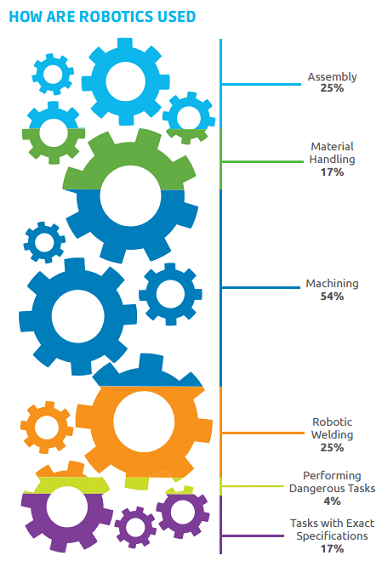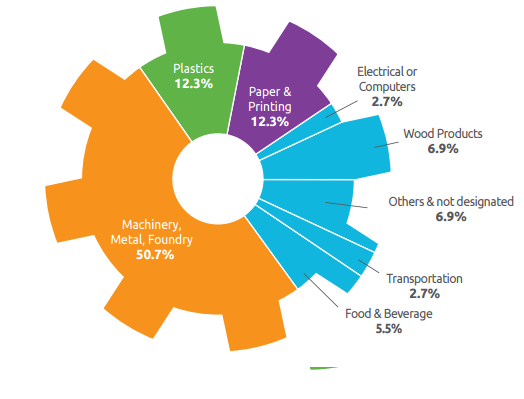Recent Survey Shows…The Majority of Wisconsin Manufacturers Are Not Using Robotics—Or 3D Printing—Yet
Robots soon will be cleaning your home, walking the dog, driving you to work, making dinner and washing the dishes, and running those kids like the efficient nanny you always dreamed of. No longer exhausted from the abysmal tasks of ordinary life, you’ll only have to give a command or push a button. Soon, soon….soon….that’s what we’ve been thinking and hearing since the advent of Star Trek.
For those in manufacturing, it’s been the case of more streamlined production on the line, greater efficiency overall, and a major savings on the bottom line. And while we might not quite have that computerized home assistant we’ve been dreaming of yet, in manufacturing, there are already many different options and machines available today from completely 3D printed machines with robotic arms to a growing variety of combinations, some all 3D printed and some not—even those that may be capable of reproducing on their own.
 Now, with so much available for those invested in manufacturing, why are companies in the state of Wisconsin not using the power of robotics to their advantage? In a recent report of a survey released by Schenck SC, it would seem that many companies in Wisconsin are indeed still not using the technology, despite findings that shipments and orders for robots actually set new records last year.
Now, with so much available for those invested in manufacturing, why are companies in the state of Wisconsin not using the power of robotics to their advantage? In a recent report of a survey released by Schenck SC, it would seem that many companies in Wisconsin are indeed still not using the technology, despite findings that shipments and orders for robots actually set new records last year.
In their survey to gain information, Schenck received information from 84 varied companies in manufacturing, from metal to machinery manufacturing to plastics, paper, and printing.
“Respondents’ revenues ranged from less than $1 million to in excess of $500 million, with 65% concentrated in the $5 million to $50 million range,” states the report.
With those figures, it does cause some curiosity as to why 70% of manufacturing firms are not using robotics at all despite the obvious availability. Most of these companies have intentions of moving ahead with the times very soon though, with that figure dropping to 53% in the next one to three years. Reluctance to dive in to the use of robotics seems to stem mostly from not seeing the benefits of robotics to not really understanding what they would use them for.
Of those currently using robotics in their operations:
- 54% used them for machining
- 25% for assembly
- 25% for robotic welding
“About half of the respondents have integrated one to three robots in their factory with one quarter having in excess of 10 robots,” states the report. “Of those respondents currently integrating robots in their factory, nearly 90% anticipate increasing their investment in the next 3 to 5 years.”
Those using robotics are definitely feeling the positive effects, with 83% indicating increased productivity, and a close second and third indicating better costs in production, and better use of labor.
“Greater customer satisfaction was only identified by a third of the respondents, though the other benefits have resulted in greater customer satisfaction,” states the report. “Respondents noted that robotics has allowed them to increase output with the same number of workers and ensure higher quality and better on time delivery performance.”
The question of 3D printing and additive manufacturing was an important question after the subject of robotics, and the future there looks extremely promising. For most, 3D printing was brought into play only for prototyping, showing that many companies have not progressed past that original use despite so many other benefits and functions now available through the technology. A quarter of those using additive manufacturing are doing so for end-use products, as well as:
- Producing complicated parts that require multiple components and subassemblies
- Replacement parts for existing equipment and producing masters for silicone molding
- Investment casting
- Sand casting
“Various additive manufacturing trade publications predict the growth in additive manufacturing to be rapid and substantial with a projected global value of the industry to reach more than $10 billion by 2021,” states the report. “Industrial applications are especially attractive with the use of metals, especially advanced materials such as titanium. The ability to produce customized parts for an individual has already been demonstrated in the medical and orthodontic sectors.”
That is all of course more than corroborated by the many stories we follow highlighting metal 3D printing today, along with many new materials offered to customers, along with the use of 3D printed titanium implants in medicine. Benefits stated by those using the technology are both the ability to make small quantities of complex parts as well as producing less waste and ‘scrap.’
“The most popular additive manufacturing tools used by the respondents were vat photopolymerisation, which uses a vat of liquid photopolymer resin out of which a model is constructed layer by layer, and material jetting, where a material is jetted onto a build platform using a continuous or drop on demand approach,” stated the report. “Sheet lamination and directed energy deposition were not utilized by any of the respondent.”
In terms of why Wisconsin manufacturers are not using robotics, the real question is just when they will begin. The enthusiasm and forward looking attitude does seem to be there, but with a slow start. Surprisingly, 3D printing seems to becoming much more accepted as a technology today, especially with the recent rise in 3D metal printing. While only one-sixth are using it right now, that might be a surprising number for some already. Another one-sixth plan to begin using it within the next 36 months. The majority of those (90%) not using the technology simply had not found an application for it, and the rest found it to be cost-prohibitive.
Schenck, headquartered in Appleton, is one of the nation’s top 50 full-service CPA and consulting firms. They provide accounting, and tax and business consulting services. With over 600 employees, they serve clients in eight different locations in Wisconsin. Discuss this study further over in the Wisconsin Robotics & 3D Printing forum at 3DPB.com.
[Sources: BizTImes; Schenck SC / Images: Schenck SC]Subscribe to Our Email Newsletter
Stay up-to-date on all the latest news from the 3D printing industry and receive information and offers from third party vendors.
You May Also Like
Profiling a Construction 3D Printing Pioneer: US Army Corps of Engineers’ Megan Kreiger
The world of construction 3D printing is still so new that the true experts can probably be counted on two hands. Among them is Megan Kreiger, Portfolio Manager of Additive...
US Army Corps of Engineers Taps Lincoln Electric & Eaton for Largest 3D Printed US Civil Works Part
The Soo Locks sit on the US-Canadian border, enabling maritime travel between Lake Superior and Lake Huron, from which ships can reach the rest of the Great Lakes. Crafts carrying...
Construction 3D Printing CEO Reflects on Being Female in Construction
Natalie Wadley, CEO of ChangeMaker3D, could hear the words of her daughter sitting next to her resounding in her head. “Mum, MUM, you’ve won!” Wadley had just won the prestigious...
1Print to Commercialize 3D Printed Coastal Resilience Solutions
1Print, a company that specializes in deploying additive construction (AC) for infrastructure projects, has entered an agreement with the University of Miami (UM) to accelerate commercialization of the SEAHIVE shoreline...
































